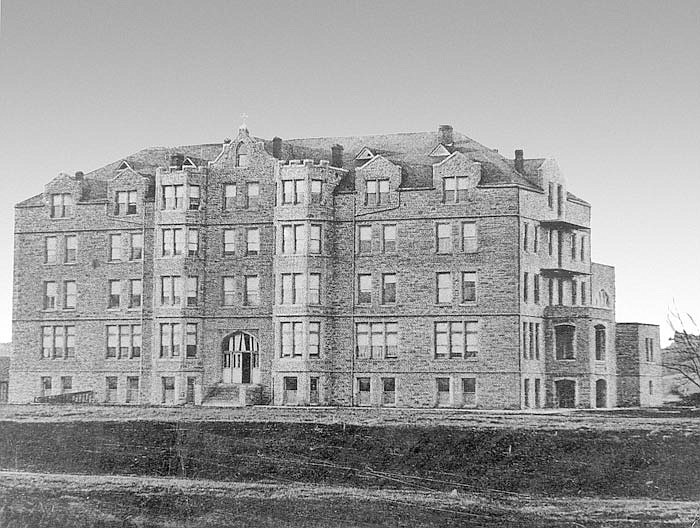When the Sisters of St. Mary came with the charge of establishing a hospital in Jefferson City, they brought with them the legacy of grace and affection of caring for the poor and sick.
Their concern for each person - whether patient or the staff member - was apparent when Rosemarie Turner took her first job out of nursing school there in 1956. Ed Sandbothe found the same zeal and compassion from the nuns when he arrived at the boys house in 1944 at the age of 11.
"When the nuns came into the room, there was such a calmness and you knew you were being taken care of,"
Turner said.
After three years operating in a house at Elm and
Bolivar streets, the first permanent building for St. Mary's Hospital was dedicated in 1905 on land donated by the Jacob Moerschel family. But a fire gutted the hospital in 1919, according to local historian Gary Kremer.
"Undaunted by the hospital's destruction, the sisters resolved to rebuild, using the original structure's undamaged exterior walls," Kremer said in Heartland History, volume three.
Rededicated in 1920, it was designated as a city Landmark in 2006.
With the eventual relocation of St. Mary's Health Center, the fate of the historic hospital setting is undetermined.
"I hate to see them abandon it; it's home to me," Sandbothe said. "But you've gotta move on."
Turner recalled from her decades of work spanning several expansions, "you use every corner and every room but you just run out of space."
Heather Feeler, communications coordinator, said the hospital will work with city and chamber officials to find the best fit that will honor the historic building.
But the impact of what the sisters started and their mercy has had on this community spreads across generations. In Sandbothe's case, the hospital literally touched generations of his family, as his father, then he and his siblings and even his children have worked there at
some point.
The boys house, where Sandbothe stayed, and the girls house took in children and adults who needed jobs or access to school.
In 1944, work was slim in his hometown of Vienna, so Sandbothe's parents moved with their dozen children to Jefferson City.
Like most children, Sandbothe would wake up at 5:45 a.m. to the sound of the phone. Then the bell - which now rings at his grandchildren's hands on his rural Taos farm - tolled for 6 a.m. Mass. Then it was breakfast and chores before school. After school, there was more work to be done.
As in his adult career in maintenance, they didn't work 40-hour weeks; "we worked until the job was done," Sandbothe said.
"There was a lot of work but nobody thought about it."
As a child, Sandbothe worked in the kitchen with Sister Bertina, a short, Polish nun with a great sense of humor, he said.
"She taught me through giving is how you receive," Sandbothe said.
Most days while he was there in the mid-1940s, several "bums" who were riding the rails would sit on what became known as the "bum bench."
"They knew if they would st on that bench, they would get fed," Sandbothe remembered.
He also learned "cleanliness is next to godliness" from them.
Keeping the hospital clean probably is Sandbothe's proudest achievement. But he said he also is proud of the mechanisms perfectly drilled into the rock to hang the metal sign of a nun holding a baby.
Sandbothe and Turner both remember many mornings when a dozen patients would line the halls with screens in between waiting for rooms. And it was Sandbothe's job to go to the store room to pull out the spare beds.
Turner remembered the thick German accent of Sister Bernadette, who hired her in 1956 and supervised all aspects of the hospital administration that takes dozens of people today.
"They were strict but good role models for me," she said of the more than 30 nuns who lived there when she started.
They lived in the hospital initially, and later in a convent beside it. They always had a presence in the halls until the 1960s when government regulations and different Catholic leadership started changes.
In 1963, Turner became the first lay supervisor - she eventually served as director of nursing and then director of customer services. That was but one of many changes the hospital, its staff and its services have seen in its 104 years.
Technology has helped care for patients. But one thing Turner misses is the nursing uniforms - white gowns, hose, shoes and caps designating their skill level with a pin designating the school they graduated from. "I was proud to wear it," Turner said. "It let's people know who's taking care of you." What the sisters cultivated was a sense of family that continues through the hospital's auxiliary and the monthly luncheons for retirees. Turner, who still works with the auxiliary, said the hospital feels like home. "I grew up there," she said. Sandbothe agreed, "(the sisters') guidance and prayers got me to where I am today."



